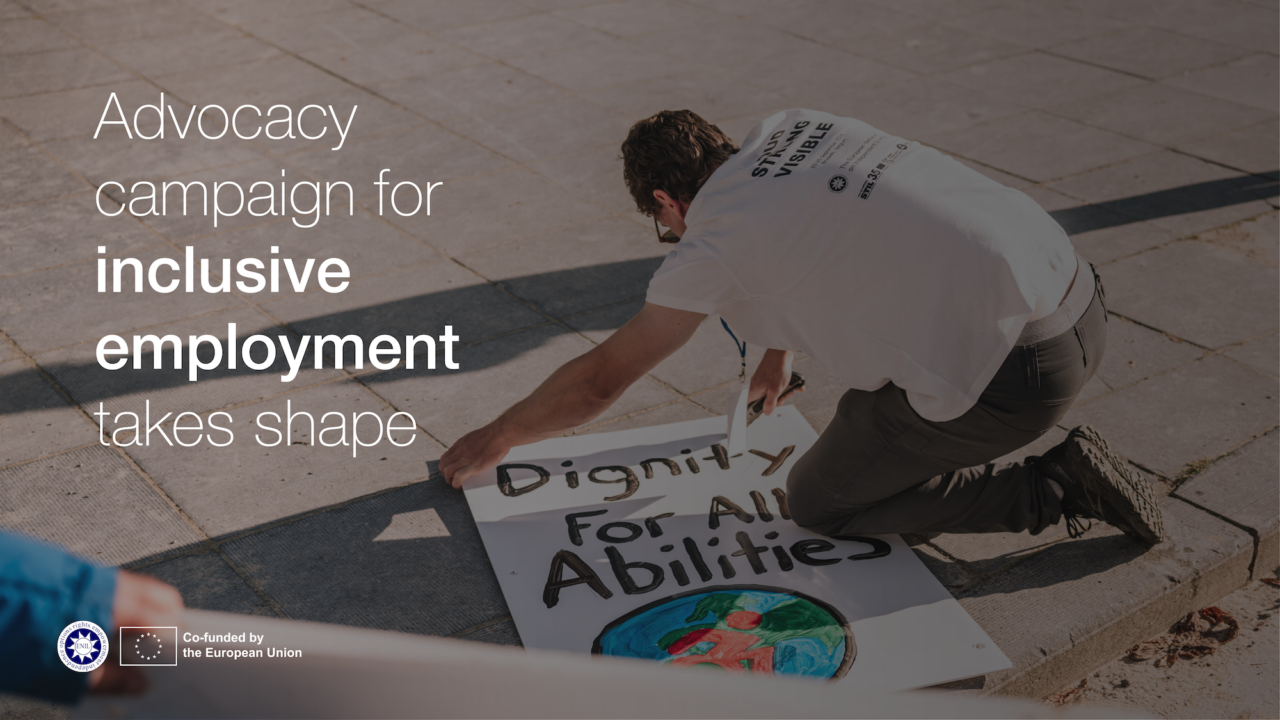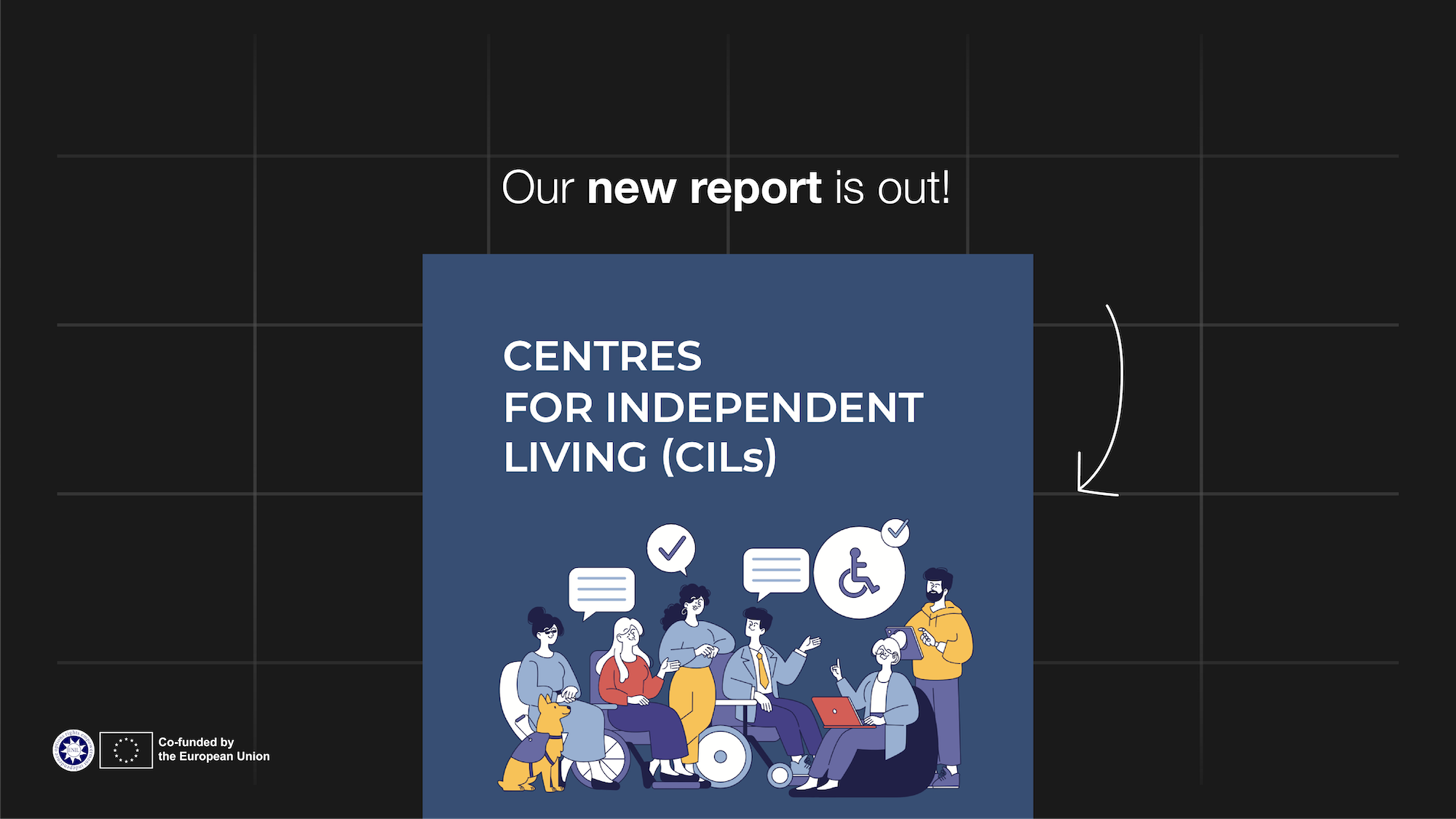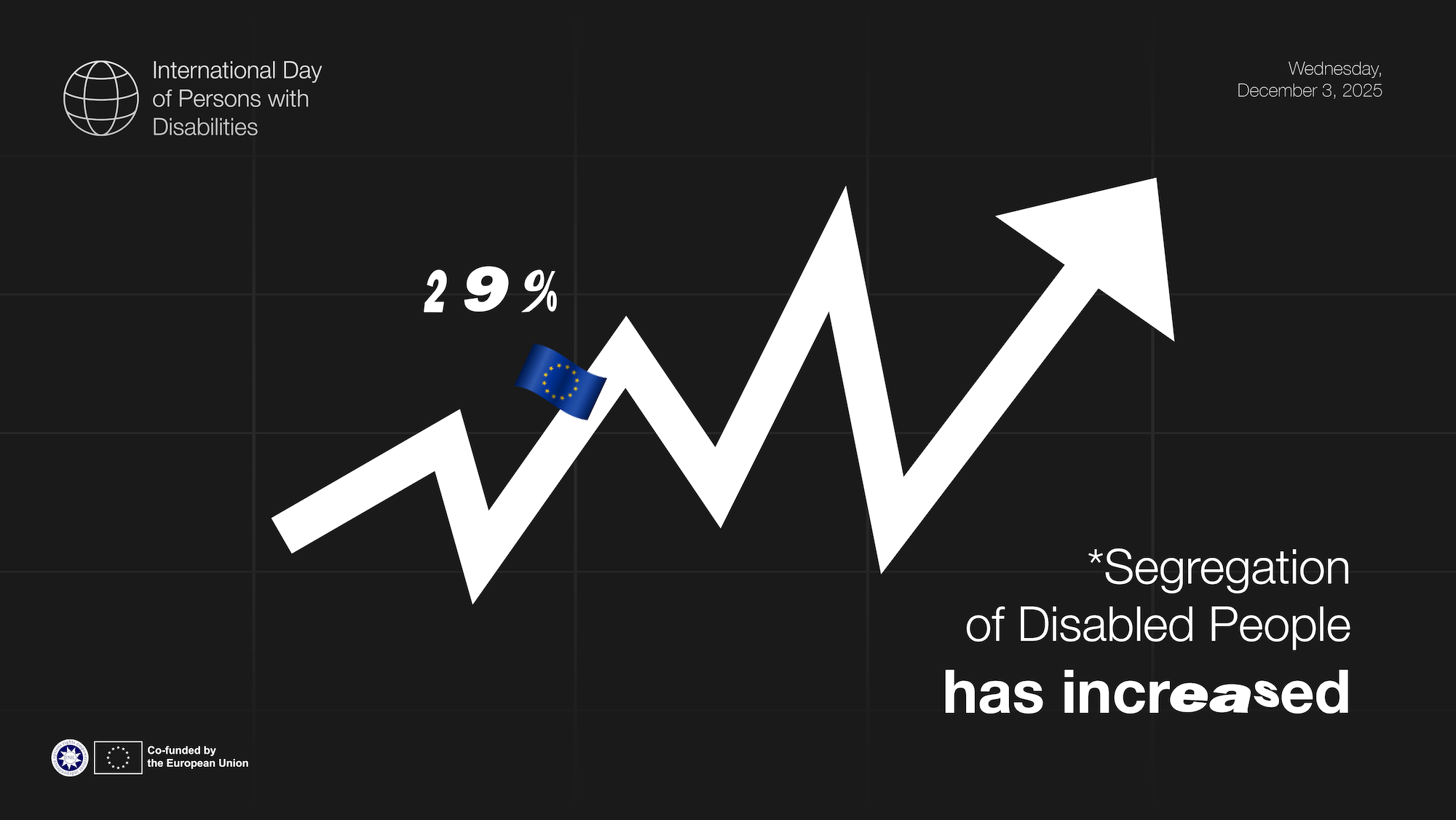By Florian Sanden
This article provides an analysis of EU policy making on employment for disabled people, presents the ENIL proposal for reform and proceeds to describe our advocacy campaign from a methodical point of view. Part I “Analysing EU disability employment policy” presents the analysis. Part II “ENILs´ advocacy campaign”describes the campaign.
I Analysing EU disability employment policy
According to the Commissioner for Equality, preparedness and crisis management, Hadja Lahbib, the Employment Equality Directive, which was adopted 25 years ago, is “a tested and trusted non-discrimination framework”.
The European Disability Strategy 2010-2020, published in 2010, indicated that the employment rate of disabled people stood at around 50%. According to a study by the European Disability Forum, the employment rate in 2023 stood at 51,3%. In 2010, the employment rate of non-disabled people stood at 68,6%. Currently, it stands at 75,8%. Thus, while the employment rate of non-disabled people increased 7,2%, the employment rate of disabled people only gained 1,3%. In 2010 the disability employment gap stood at 18,6% and in 2023 at 24,5%.
During most of the time the employment equality directive has been in force, the employment of non-disabled people has grown far quicker than the employment of disabled people and disability employment gap has widened. We are further from access to employment on a level equal to others, than ever.
One outcome, many causes
The obvious reason for this most unsatisfactory outcome is that the employment equality directive does not provide effective protection against discrimination. However, there are more causes. As evidenced by the recently published European Commission study on alternative employment models, there is also a disability education gap. Disabled people are still less likely to receive a secondary or tertiary level degree than their non-disabled peers. In 2022, 22,2% of disabled young people left education and training early compared to 8,4% of their peers. Overly protective attitudes of families, rigid benefit systems and stigmatization are mentioned as other factors.
The choice for sheltered employment
An important cause for the increasing disability employment gap is to be found in the choice of policy makers for sheltered employment and against supported employment. During the last decade resources flowing into this instrument have greatly increased throughout in several EU countries.
According to the study “Fostering employment through sheltered workshops: reality, trends and next steps” published by EASPD, the number of disabled people using such services in Finland increased from 15.805 in 2011 to 17.871 in 2021, in Spain from 56.332 in 2009 to 98.551 in 2021. In the Czech Republic the number increased by 14.500 in 2016 to 63.000 in 2021. In Germany the number of sheltered workshops increased from 688 to 734 in 2019. Approximately 320 000 disabled people work in the countries´ sheltered workshops.
ENILs´ own research shows that significant financial resources are being used. The government of the Belgium region Vlaanderen has announced to spend EUR 30 million on sheltered employment to create 1000 additional places. Sweden is subsidizing the provider Samhall with EUR 500 Mio. Per year. Germany will invest at least EUR 33,34 million to build new facilities or renovate existing ones over the next years.
According to the EASPD study, policy makers see sheltered employment as the default option, the only realistic option for disabled people to find work. Also, ENIL has gathered evidence which shows that when confronted with the choice between various options, authorities choose sheltered employment.
A disastrous performance
The choice for sheltered employment is usually justified with two arguments. First, that it is an effective instrument to generate transitions into regular work. Second, that some disabled people are not capable of working regular jobs.
In European Commission study on alternative employment models investigated transition rates. The following evidence was found:
- In Austria only 0,7% of persons working in sheltered workshops make the transition
- For Germany studies indicate a transition rate of less than 1%. A study from 2023 by the Ministry of Social Affairs established a transition rate of 0,35%
- For the Netherlands it is less than 1%
- For Spain it is 0,55%
- For Sweden, the transition rates are comparatively good and reach 6% to 7%
The study contains a longer list.
Sheltered employment is clearly not an effective instrument to enable disabled people to find regular work. On the contrary, it represents a barrier moving disabled workers further away from fair employment.
The aforementioned EASPD study documents of exploitative nature of sheltered employment. Providers often produce goods and services sold to regular companies to generate revenue or profits. In sheltered employment workers are defined as services users, not as employees and thus often do not receive more than a small compensation for their work.
Boosting the alternatives: From sheltered to supported employment
Do these figures mean that some disabled people are indeed incapable of working regular jobs?
Evidence from supported employment programs show that this is not the case:
- A study from Germany found 63% of participants were in employment in the open labour market six months after the end of the intervention, 62% 12 months later, 57% 24 months later
- Another, older study followed up with 251 persons mainly with intellectutal disabilities more than five years after they had transitioned from sheltered workshops to the open labour market via supported employment. Five years after the initial placement, 65% of the participants were still in employment
- Evaluation of a 2015-2017 supported employment pilot in Ireland found 33 of the 95 participants in paid employment over a two-year span
- Research on supported employment schemes in Italy found 54% were in employment during the year
- A study from the Netherlands from 2022 followed 168 participants of a programme. After two years, 45% of participants had found paid employment
- In Sweden a supported employment program helped 46% of participants find employment, as opposed to 11% of vocational rehabilitation in 18 month follow up
Supported employment refers to various forms of support provided while a disabled person is working a regular job. It can entail personal assistance at work, job coaching or wage support. Also job carving, e.g. designing a job profile that meets the needs of the disabled person, is an accepted measure.
The study on alternative employment models contains evidence according to which beneficiaries of supported employment enjoy better long-term earning outcomes and less dependency on public benefits.
There is strong evidence suggesting that the incapacity hypothesis is wrong.
Unfortunately, in many countries supported employment programmes are small compared to sheltered employment. The available resources mostly go into sheltered employment.
Underappreciated regulatory powers
The origins of the EU date back to the signing of the treaty of Rome in 1957 creating the European Economic Community (EEC). The purpose of the EEC was to create an internal market, allowing member countries to export goods and services without restrictions. Maintaining the internal market is still among the core competences of the European Union today.
To ensure fair competition in the internal market, the EU possesses strong competences in the area of competition law. The treaties grant the Union exclusive competences in this area. Brussels is able to regulate under which conditions national administrations can grant subsidies to companies, an area of law which is referred to as state aid. Subsidies to individual companies are forbidden if competition in the internal market is endangered thereby. Social Services are strongly affected by those regulatory powers.
To promote social interests, it is permitted to subsidise certain services. The 2009 European Commission Communication “Criteria for the analysis of the compatibility of State Aid for the employment of disadvantaged and disabled workers” argued that state aid legislation should be adjusted to promote the employment of groups affected by barriers preventing them from entering the labour market.
The General Block Exemption Regulation is a key part of the state aid regulatory framework and establishes a positive list of a wide variety of goods and services national administrations are allowed to subsidise. To promote the employment of disabled workers, the following instruments may be funded:
- Wage support
- Personal assistance at work
- Purchase of equipment
- Modifications of the built environment
- Transport
- Rehabilitation
- Sheltered employment
As shown, administrations do not make use of instruments falling under supported employment and focus their resources on the instrument which is not only ineffective but counterproductive.
Compliance with the UN CPRD
According to UN CRPD article 27 disabled people have the right to work on a basis equal to others. According to General Comment No 8 “segregated employment for persons with disabilities, such as sheltered workshops, is not to be considered as a measure of progressive realisation of the right to work”.
Sheltered employment is not compliant with the UN CRPD.
What the EU should do
The facts and figures gathered in this article show:
- Disabled people are strongly excluded from employment
- Governments invest huge amounts of financial resources into an instrument which is counterproductive
- Sheltered employment is not compliant with the UN CRPD
For ENIL it is evident that we need a policy change, away from sheltered and to supported employment. For that to happen we need to redirect financial resources. Due to the competences on state aid, the EU has the ability and due to being state party to the UN CRPD also the moral duty to significantly contribute to this change.
ENIL is proposing to remove the option of subsidising sheltered employment from the positive list contained in the General Block Exemption Regulation. This change would mostly affect expenses for the construction and renovation of sheltered employment facilities. National administrations would still be able to finance sheltered employment. However, this step would complicate the financing thereof and if combined with an increased promotion improve the willingness to use supported employment instruments.
In concrete, ENIL is recommending the deletion of article 34(2)(f) of the General Block Exemption Regulation. According to our proposal, the following paragraph would be removed
“where the beneficiary provides sheltered employment, the costs of constructing, installing or modernising the production units of the undertaking concerned and any costs of administration and transport, provided that such costs result directly from the employment of workers with disabilities”
II ENILs´ advocacy campaign
In 2023, ENIL published its first report on the use of state aid for the financing of institutions and sheltered workshops to prepare future advocacy action. In 2024, a briefing was published focusing specifically on sheltered employment and advancing for the first time our proposal for reform. In 2025, ENIL published its most detailed report so far.
First dissemination
To start communicating our proposal to stakeholders and decision makers an online event was organised. Member of the European Parliament Katrin Langensiepen listened to our presentation and spoke about her position on sheltered employment, showing support. The European Commission was also represented by a speaker and expressed scepticism.
To communicate the idea to a broader public, an article was published in the Social Europe Online-Journal.
Cooperation with the CRPD-Committee
At the beginning of 2025, the periodic review of the EU as state party to the UN CRPD by the Committee on the Rights of Persons with Disabilities (CRPD-Committee) reached its climax. ENIL submitted a report, providing an evaluation of the implementation of the UN CRPD by the EU. The report contained a section on state aid and sheltered employment, highlighting the various problems.
During the review sessions in Geneva on the 11th and 12th of March 2025, the EU delegation was questioned by the rapporteur Prof. Markus Schefer about the legality of the funding of sheltered employment under state aid legislation. At the time, the EU delegation was not prepared to reply to questions.
On the 21st of March, the Concluding Observations to the combined second and third periodic review of the EU were published. The CRPD-Committee resolved to support a reform of the General Block Exemption Regulation, and call on the EU to remove article 34(2)(f):
“Repeal legislation that allows public financing of segregated forms of employment for persons with disabilities, such as institutions and other segregated facilities … repeal article 34(2)(f) of the General Block Exemption Regulation … and prohibit state aid on segregated employment”
Shaping the agenda
To communicate the conclusions of the CRPD-Committee to decision-makers and stakeholders, ENIL organised an event in the European Parliament. At the event, member of the Committee on the Rights of Persons with Disabilities and rapporteur for the EU, Prof. Markus Schefer, presented the call for reform in greater detail. MEP Katrin Langensiepen spoke about her position concerning sheltered employment and voiced strong support for the proposals advanced by ENIL and the CRPD-Committee. DG Justice Director Ana Carla-Pereira spoke on behalf of the European Commission, establishing a constructive dialogue with Prof. Schefer and ENIL. A report of the event is available here.
Due to ENILs´ proposal, state aid was an agenda item at the meeting of the Disability Platform in June. The Disability Platform is a regular, formalised meeting configuration involving the European Commission, national governments and civil society organizations which is important for preparing future decisions. Recently, ENIL was accepted as a member of the subgroup on employment.
ENIL has included our reform proposal in our recommendations for the European Disability Strategy 2026-2030 and our recommendations to the Danish Presidency of the EU Council. State aid will feature in upcoming meetings with the European Commission and the Danish Presidency.
Next steps
Our campaign was successful in bringing a new but challenging topic onto the agenda. Developing technical expertise and cooperating with the CRPD-Committee proved crucial.
Step two, achieving actual legislative change, will be significantly more difficult. The European Commission could decide to change the General Block Exemption Regulation without involvement of the European Parliament and the EU-Council, but it will be reluctant to do so. Many member states rely strongly on sheltered employment, and the Commission will want to avoid the dissatisfaction of national administrations. On the other hand, the ease of changing the regulation and the wish to score points with the CRPD-Committee might provide incentives.
Going forward, ENIL will need more allies, within the European Parliament, among national governments and among organisations.
During our event in the European Parliament, Rhoda Garland, the Commissioner for the Rights of Persons with Disabilities of Malta, expressed strong support for our proposal. This support might help to convince the Maltese government to cooperate with us. Our partner organisation, Inclusion Europe, is supportive of a greater role for supported employment. ENIL will take steps to deepen this cooperation and seek additional allies.
With the help of MEP Katrin Langensiepen, and possibly other MEPs, it might be possible to make state aid and sheltered employment topics in the Committee for Employment and Social Affairs of the European Parliament.
ENIL will keep you informed about how the campaign progresses.



